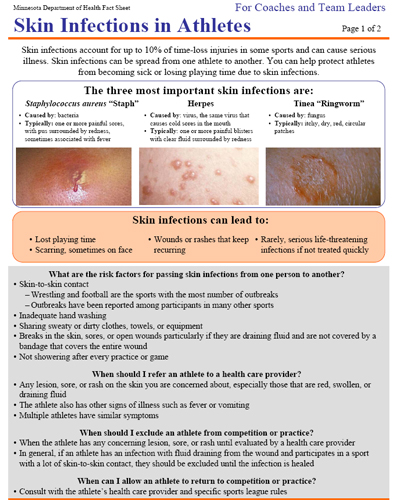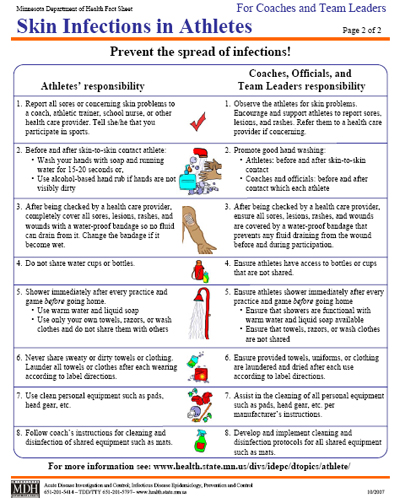Contact Info
Infectious Disease Epidemiology, Prevention and Control Division
651-201-5414
Skin Infections: Information for Coaches and Team Leaders
Download a print version of this document:
Skin Infections: Information for Coaches and Team Leaders (PDF)


Skin infections account for up to 10% of time-loss injuries in some sports and can cause serious illness. Skin infections can be spread from one athlete to another. You can help protect athletes from becoming sick or losing playing time due to skin infections.
Skin infections can lead to:
- Lost playing time
- Scarring, sometimes on face
- Wounds or rashes that keep recurring
- Rarely, serious life-threatening infections if not treated quickly
The three most important skin infections are:
- Staphylococcus aureus “Staph”
Caused by: bacteria
Typically: one or more painful sores, with pus surrounded by redness, sometimes associated with fever
- Herpes
Caused by: virus, the same virus that causes cold sores in the mouth
Typically: one or more painful blisters with clear fluid surrounded by redness
- Tinea “Ringworm”
Caused by: fungus
Typically: itchy, dry, red, circular patches
What are the risk factors for passing skin infections from one person to another?
- Skin-to-skin contact
- Wrestling and football are the sports with the most number of outbreaks
- Outbreaks have been reported among participants in many other sports
- Inadequate hand washing
- Sharing sweaty or dirty clothes, towels, or equipment
- Breaks in the skin, sores, or open wounds particularly if they are draining fluid and are not covered by a bandage that covers the entire wound
- Not showering after every practice or game
When should I refer an athlete to a health care provider?
- Any lesion, sore, or rash on the skin you are concerned about, especially those that are red, swollen, or draining fluid
- The athlete also has other signs of illness such as fever or vomiting
- Multiple athletes have similar symptoms
When should I exclude an athlete from competition or practice?
- When the athlete has any concerning lesion, sore, or rash until evaluated by a health care provider
- In general, if an athlete has an infection with fluid draining from the wound and participates in a sport with a lot of skin-to-skin contact, they should be excluded until the infection is healed
When can I allow an athlete to return to competition or practice?
- Consult with the athlete’s health care provider and specific sports league rules
Prevent the spread of infections!
|
Athlete's responsibilities:
|
Coaches, Officials, and Team Leaders responsibilities:
|
|
|
Last Updated: 10/05/2022